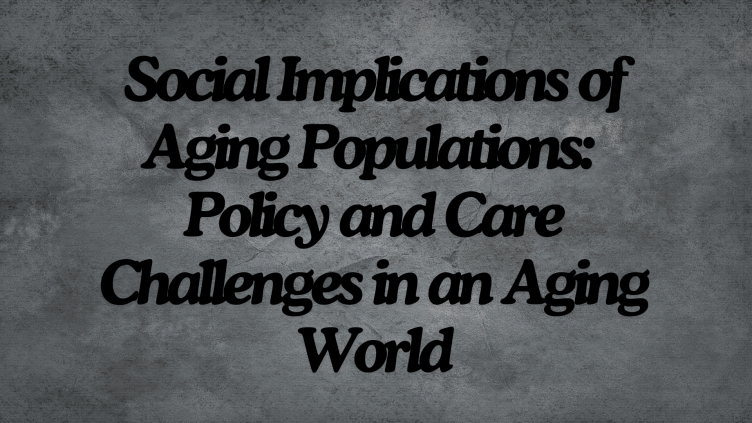Aging is a universal reality that each of us faces as we traverse the stages of life. However, when we look at this phenomenon on a societal level, the implications are profound and multifaceted. Aging populations around the world are presenting unprecedented challenges and opportunities, reshaping everything from healthcare to economic policies, and even our social fabric. Today, let’s dive into the social implications of aging populations, explore the policy and care challenges they bring, and see how these issues are highly relevant in our current times.
The Global Aging Trend: Setting the Scene
Globally, the number of older adults is increasing at an astonishing rate. According to the United Nations, by 2050, the number of people aged 60 and above is projected to double to over 2 billion. In some countries, particularly in Europe and East Asia, more than a third of the population will be over 65. This demographic shift is largely due to lower birth rates and increased life expectancy, thanks to advancements in healthcare and living conditions.
Social Implications: More Than Just Numbers
1. Healthcare Systems Under Pressure
As populations age, the demand for healthcare services escalates. Older adults are more likely to suffer from chronic conditions such as heart disease, diabetes, and arthritis, requiring continuous and often complex medical care. This surge in demand puts immense pressure on healthcare systems, which are already stretched thin in many parts of the world.
For instance, in Japan, which has the highest proportion of elderly citizens, hospitals and care facilities are struggling to keep up. There are increasing reports of “hospital refugees,” elderly patients who cannot be discharged due to the lack of adequate home care services. This phenomenon highlights a critical gap in the continuity of care, pointing to the urgent need for robust long-term care policies.
2. Economic Impact: The Silver Economy
While the rising number of retirees can strain public pension systems and reduce the workforce, it’s not all gloom and doom. The concept of the “silver economy” — economic activities catering to the needs of older adults — is gaining traction. From healthcare and pharmaceuticals to leisure and travel, businesses are tapping into this lucrative market.
In the United States, for example, the spending power of adults over 50 was estimated to be over $7 trillion in 2020. This demographic is driving growth in sectors like housing, with an increasing demand for age-friendly homes, and technology, with a surge in health-monitoring devices and services tailored to enhance the quality of life for seniors.
3. Social Inclusion and Isolation
Aging can often lead to social isolation, which has been shown to have severe implications for mental health and overall well-being. In many cultures, older adults are revered and play a central role in family and community life. However, modern urbanization and the breakdown of extended family structures have left many elderly individuals living alone, with limited social interaction.
Countries like the United Kingdom have recognized this issue, appointing a Minister for Loneliness to address the growing problem. Innovative community programs, such as intergenerational housing projects, are emerging as solutions to foster connections between the young and the old, enriching lives on both ends of the age spectrum.
Policy Challenges: Navigating the Complex Landscape
1. Pension Systems and Financial Security
One of the most pressing policy challenges is ensuring financial security for the aging population. Many countries are grappling with the sustainability of their pension systems as the ratio of working-age individuals to retirees declines.
In France, for instance, pension reforms have sparked widespread protests, highlighting the delicate balance policymakers must strike between extending working lives and providing adequate retirement benefits. The situation calls for innovative solutions like flexible retirement plans and incentives for older workers to remain in the workforce longer.
2. Long-Term Care Infrastructure
Building a robust long-term care infrastructure is critical. This includes not only physical facilities like nursing homes and assisted living but also a well-trained workforce to provide care. The World Health Organization (WHO) emphasizes the need for integrating health and social care services to address the comprehensive needs of the elderly.
Countries like Sweden have made significant strides in this area, implementing comprehensive eldercare systems that combine home care, community support, and residential care options. These models can serve as blueprints for other nations aiming to improve their long-term care frameworks.
3. Technological Integration
Technology can play a pivotal role in addressing the challenges of an aging population. From telemedicine and remote health monitoring to robotic assistants and smart home technologies, the potential for innovation is vast. However, ensuring that older adults can access and effectively use these technologies remains a challenge.
In South Korea, one of the most tech-savvy countries, initiatives like the “Silver ICT” program are being developed to enhance digital literacy among the elderly. This includes training programs and user-friendly devices designed to meet the specific needs of older users.
Current Relevance: Why It Matters Now
The COVID-19 pandemic has underscored the vulnerabilities of older adults, particularly in long-term care facilities where the virus spread rapidly and lethally. This global crisis has brought the issues of elder care and social isolation into sharp focus, prompting urgent calls for reform.
Moreover, the aging population trend is not confined to a few countries but is a global phenomenon that requires a coordinated international response. The insights gained from countries already facing these challenges can help others prepare and adapt their policies accordingly.
Moving Forward: Embracing the Aging Society
Addressing the social implications and policy challenges of aging populations requires a holistic approach that combines healthcare, economic, social, and technological strategies. It calls for collaboration between governments, private sectors, and communities to create environments where older adults can thrive.
Fostering Intergenerational Solidarity
Promoting intergenerational solidarity is crucial. Encouraging interactions between different age groups can mitigate the risks of social isolation and build a more cohesive society. Programs like Japan’s “Fureai Kippu” (Caring Relationship Tickets) — a time-banking system where individuals earn credits for providing care to the elderly, which they can later use for their own care needs — exemplify innovative approaches to foster community support.
Empowering the Elderly
Empowering older adults through lifelong learning opportunities and active participation in society can significantly enhance their quality of life. The University of the Third Age (U3A) is a global movement that provides educational and social opportunities for seniors, promoting mental stimulation and social engagement.
Policy Innovation and Flexibility
Policymakers must be innovative and flexible in designing solutions that cater to the diverse needs of the aging population. This includes reevaluating retirement ages, developing mixed-care models that integrate community and home-based care, and ensuring that pension systems remain sustainable.
Conclusion
The aging population is one of the defining challenges of our time, with far-reaching social implications and policy demands. By embracing this reality with innovative thinking, compassionate care, and inclusive policies, we can turn the aging population from a challenge into an opportunity.
Creating a world where aging is seen not as a burden but as a valuable phase of life will require concerted efforts and a shift in our perspectives. As we navigate this demographic transition, let’s strive to build societies that honor and support our elders, ensuring that they can live with dignity, purpose, and joy.







